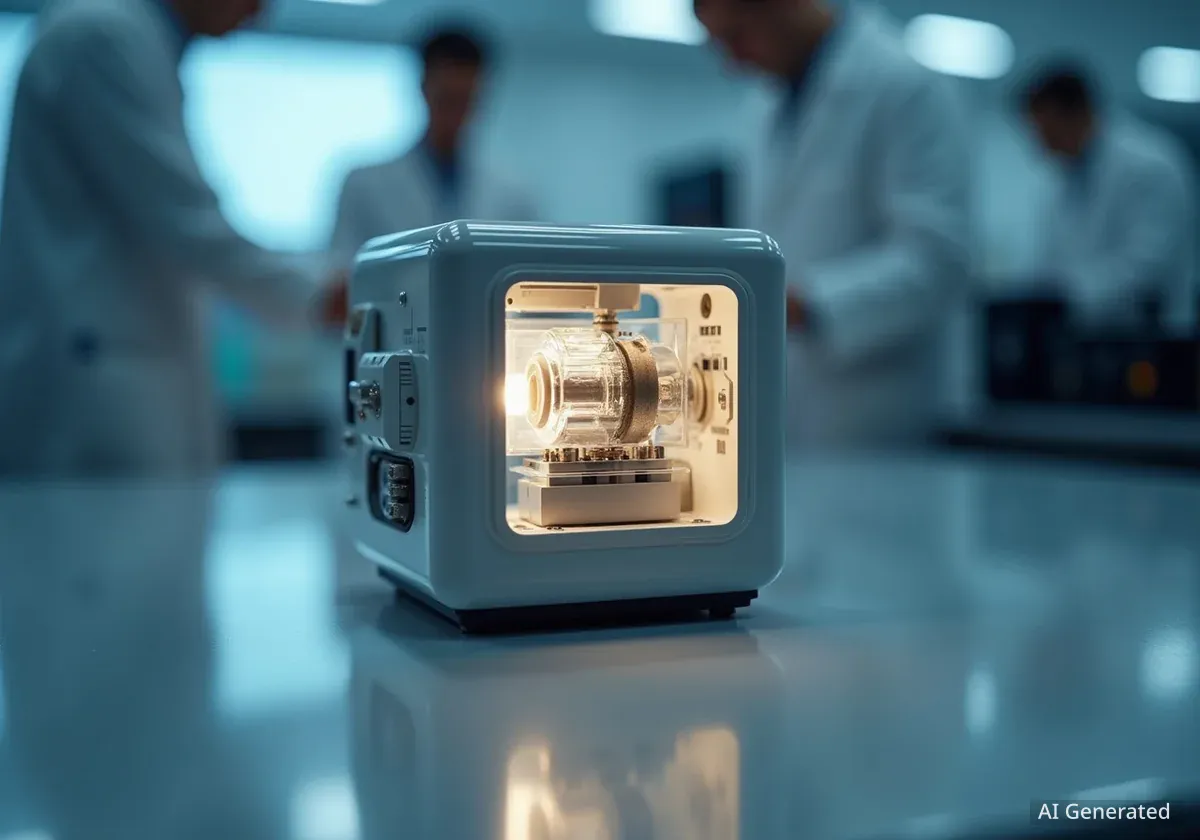A NASA-supported research team at the University of Iowa has successfully re-established and improved the manufacturing process for critical components used in space weather monitoring. The team has developed a new generation of high-performance sensors for fluxgate magnetometers, instruments essential for studying solar phenomena that can affect Earth's power grids and communication satellites.
Key Takeaways
- The University of Iowa has developed a new, reliable manufacturing process for fluxgate magnetometer cores, a technology previously lost to the civilian sector.
- The new Space Weather Iowa Magnetometer (SWIM) is approximately 30% smaller and consumes 50% less power than its predecessor, the MAGIC sensor.
- SWIM features redesigned electronics that are more resistant to radiation, making it suitable for long-duration missions in harsh space environments.
- The first flight of the SWIM sensor is scheduled for winter 2025-2026 aboard a sounding rocket mission from Norway.
Reviving a Critical Space Technology
Fluxgate magnetometers are standard instruments for measuring magnetic fields in space. They provide vital data for understanding space weather, which originates from the Sun and can have significant impacts on terrestrial and space-based infrastructure. However, these instruments rely on a specialized ferromagnetic core whose manufacturing technique, originally developed for the U.S. Navy, had been lost.
To address this capability gap, a NASA-sponsored team at the University of Iowa (UI) established a new production method from the ground up. This modern process ensures a reliable supply of high-fidelity cores for current and future space science missions.
A Modern Manufacturing Process
The UI team's manufacturing method is fully documented and independent of legacy materials or techniques. The process involves several precise steps:
- Alloy Creation: Base metal powders are melted to create custom ferromagnetic alloys.
- Foil Production: The custom alloys are rolled into extremely thin foils.
- Core Shaping: These foils are carefully formed into the specific geometric shape required for the sensor core.
- Magnetic Optimization: The shaped cores undergo a heat treatment, or artificial aging, to optimize their magnetic properties for maximum sensitivity.
This in-house capability allows the team not only to produce cores but also to integrate them into complete sensor systems, including the paired electronics. This vertical integration facilitates rapid prototyping and the exploration of new sensor designs for various mission requirements.
High Success Rate
The new manufacturing process is highly reliable. According to project data, approximately 90% of the cores produced have a noise floor performance that is comparable to or better than the previous legacy components, ensuring a consistent supply for missions.
Introducing the SWIM Magnetometer
The culmination of this renewed manufacturing capability is the Space Weather Iowa Magnetometer (SWIM). This new instrument represents a significant advancement over its predecessor, the MAGIC Tesseract sensor, which recently launched aboard NASA's TRACERS mission. While based on the same principles, SWIM introduces key improvements in size, power, and durability.
How Fluxgate Magnetometers Work
These sensors detect magnetic fields by measuring changes in a material's magnetic properties. An electrical current is passed through an inner 'drive' winding, creating a magnetic field that saturates the ferromagnetic core. This saturation changes the core's magnetic permeability, which in turn induces a voltage in an outer 'sense' winding. By analyzing the relationship between the input current and the output voltage, scientists can precisely determine the strength and direction of the external magnetic field the sensor is passing through.
Smaller Size and Mass
The SWIM sensor is about 30% smaller than the MAGIC sensor. This reduction was achieved by using three smaller, more efficient cores instead of the six larger cores used in the MAGIC design. A smaller and lighter sensor is a significant advantage for space missions.
"Mass is a major performance driver for deployable boom design and vehicle dynamics," notes the project team. A lighter sensor is easier to accommodate on the long booms used to isolate magnetometers from the spacecraft's own magnetic interference.
With a lightweight carbon-composite cover, the SWIM sensor's mass can be reduced to approximately 110 grams, making it ideal for small satellites and missions where every gram counts.
Reduced Power Consumption
By using fewer and more efficient cores, the SWIM design cuts power consumption by half compared to the MAGIC instrument. While a modest reduction relative to the entire instrument's power budget, this change has a critical impact on the sensor's performance when deployed on a boom.
Less power means less heat is dissipated at the sensor. This minimizes localized heating of the boom structure, reducing thermal gradients that can cause the boom to bend or rotate. Such deformations can affect the pointing accuracy of the sensor, so minimizing them improves the quality of the scientific data.
Upgraded for Harsh Environments
Perhaps the most significant change in the SWIM design is its updated electronics. The previous MAGIC system used a traditional analog design that required high-performance components sensitive to radiation. This limited its use in high-radiation environments, such as Earth's radiation belts or on long-duration planetary missions.
SWIM's electronics employ digital demodulation and a temperature-compensated digital feedback system. This modern topology allows the use of components that are inherently more tolerant to radiation exposure. This strategic redesign greatly expands the potential applications for the sensor, opening the door for its use on missions that travel through challenging space environments for extended periods.
Future Missions and Applications
The improved performance and durability of the SWIM magnetometer have positioned it for several upcoming flight opportunities. The technology is set to prove its capabilities in the near future, gathering crucial data about the near-Earth space environment.
The first scheduled flight for a SWIM sensor will be on the University of Oslo’s ICI-5bis sounding rocket mission. The launch is planned for the winter of 2025-2026 from the Andoya Space Sub-Orbital range in Norway. Following this, SWIM is also slated to fly on the Observing Cusp High-altitude Reconnection and Electrodynamics (OCHRE) sounding rocket.
The successful revival of this manufacturing process and the development of the advanced SWIM sensor provide NASA and the broader scientific community with a robust, high-fidelity tool for future heliophysics and planetary science missions.





